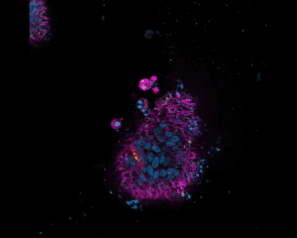Image (video) of the Month: human intestinal organoid after infection with rotavirus
Rotavirus triggers diarrhea and vomiting by infecting enterocyte cells in the small intestine. This infection results in approximately 128,000 deaths annually, particularly in children. The video shows a sequence of a z-stack of confocal images of a human intestinal organoid infected with rotavirus showing a single point in time, but different depths through the organoid. Human intestinal organoids are miniature representations of the human intestine that enable researchers to study the events that follow an infection at the cellular level.
This video was awarded first place in the 2021 FASEB BioArt contest: video category! Congratulations, Thomas!

Here, the rotavirus-infected organoid was stained with markers for rotavirus proteins (red), surface proteins (green), junctional proteins (magenta) and cell nuclei (blue). The images were acquired using confocal microscopy. Video courtesy of J.T. Gebert/Hyser lab.
J. Thomas Gebert, is a PhD candidate in the Hyser lab studying how rotavirus Ca2+ waves relate to virulence.
Dr. Joseph M. Hyser is assistant professor of molecular virology and microbiology and member of the Alkek Center for Metagenomic and Microbiome Research at Baylor.
The Hyser lab investigates how microbes exploit host calcium signaling pathways and how this relates to disease. The lab is involved in characterizing viral ion channels (Viroporins), engineering of human intestinal enteroids and studying gastrointestinal virus calcium channel blockers.





